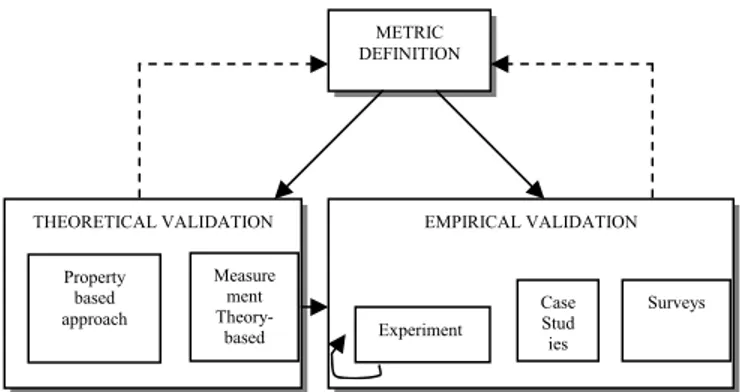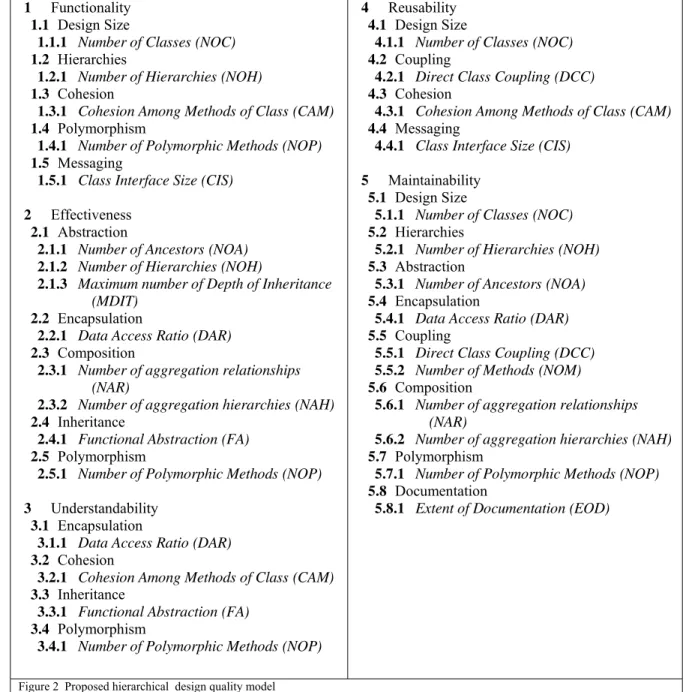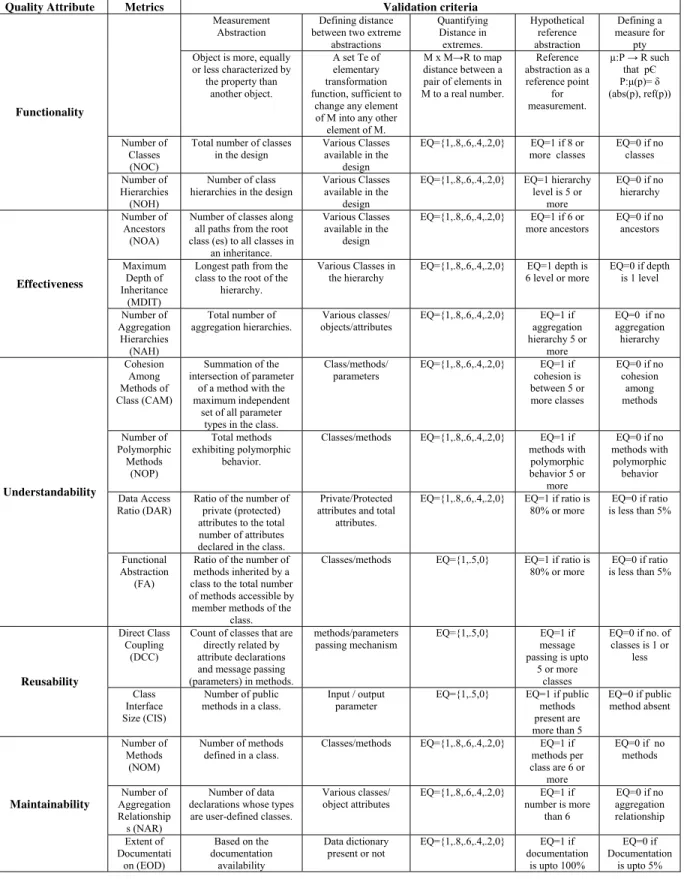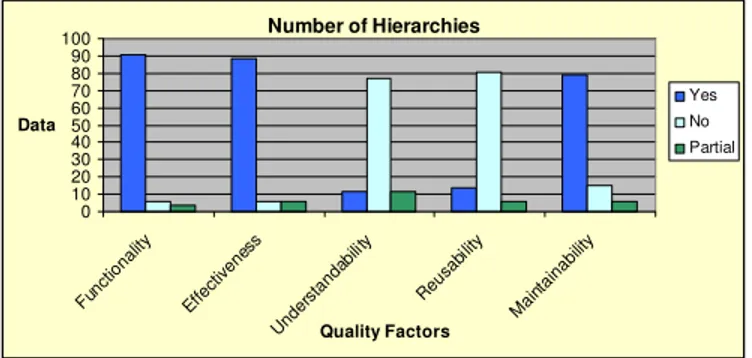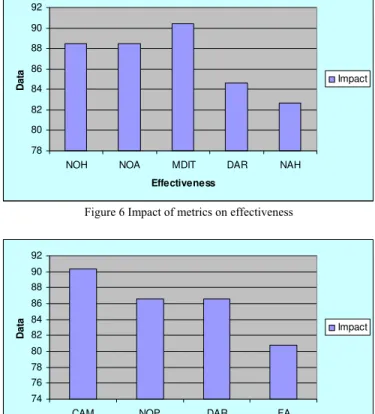Vol. 6, No.3, 2009
A Framework for Validation of Object-Oriented
Design Metrics
Devpriya Soni1
Department of Computer Applications
Maulana Azad National Institute of Technology (A Deemed University) Bhopal 462007 India
Ritu Shrivastava2, M. Kumar3 SIRT, Bhopal (India)
Abstract: A large number of metrics have been proposed for the quality of object-oriented software. Many of these metrics have not been properly validated due to poor methods of validation and non acceptance of metrics on scientific grounds. In the literature, two types of validations namely internal (theoretical) and external (empirical) are recommended. In this study, the authors have used both theoretical as well as empirical validation for validating already proposed set of metrics for the five quality factors. These metrics were proposed by Kumar and Soni.
Keywords-object-oriented software, metrics, validation.
I. INTRODUCTION
Analyzing object-oriented software in order to evaluate its quality is becoming increasingly important as the paradigm continues to increase in popularity. A large number of software product metrics have been proposed in software engineering. While many of these metrics are based on good ideas about what is important to measure in software to capture its complexity, it is still necessary to systematically validate them. Recent software engineering literature has shown a concern for the quality of methods to validate software product metrics (e.g., see [1][2][3]). This concern is due to fact that: (i) common practices for the validation of software engineering metrics are not acceptable on scientific grounds, and (ii) valid measures are essential for effective software project management and sound empirical research. For example, Kitchenham et.al. [2] write: "Unless the software measurement community can agree on a valid, consistent, and comprehensive theory of measurement validation, we have no scientific basis for the discipline of software measurement, a situation potentially disastrous for both practice and research." Therefore, to have confidence in the utility of the many metrics those are proposed from research labs, it is crucial that they are validated.
The validation of software product metrics means convincingly demonstrating that:
1. The product metric measures what it purports to measure. For example, that a coupling metric is really measuring coupling.
2. The product metric is associated with some important external metric (such as measures of maintainability or reliability).
3. The product metric is an improvement over existing product metrics. An improvement can mean, for example, that it is easier to collect the metric or that it is a better predictor of faults.
According to Fenton [4], there are two types of validation that are recognized: internal and external. Internal validation is a theoretical exercise that ensures that the metric is a proper numerical characterization of the property it claims to measure. Demonstrating that a metric measures what it purports to measure is a form of theoretical validation. External validation involves empirically demonstrating points (2) and (3) above. Internal and external validations are also commonly referred to as theoretical and empirical validation respectively [2]. Both types of validation are necessary. Theoretical validation requires that the software engineering community reach a consensus on what are the properties for common software maintainability metrics for object-oriented design. Software organizations can use validated product metrics in at least three ways: to identify high risk software components early, to construct design and programming guidelines, and to make system level predictions. The approaches used in two validations are shown in Figure 1.
Figure 1 Approaches to software metrics validation METRIC DEFINITION
THEORETICAL VALIDATION EMPIRICAL VALIDATION
Property based approach
Measure ment
Theory-based Experiment
Case Stud ies
Vol. 6, No.3, 2009
Recently, Kumar and Soni [5] have proposed a hierarchical model to evaluate quality of object-oriented software. This proposed model has been used for evaluation of maintainability assessment of object-oriented design quality, especially in design phase, by Soni and Kumar [6]. In this paper, the authors have attempted to validate the hierarchical model of object-oriented design quality metrics as given in [5]. The section II deals with theoretical validation of the model and the section III deals with empirical validation.
II. THEORETICAL VALIDATION OF PROPOSED
HIERARCHICAL MODEL OF METRICS
The main goal of theoretical validation is to assess whether a metric actually measures what it purports to measure [7]. In the context of an empirical study, the theoretical validation of metrics establishes their construct validity, i.e. it ‘proves’ that they are valid measures for the constructs that are used as variables in the study. There is not yet a standard, accepted way of theoretically validating software metric. Work on theoretical validation has followed two paths (see Fig 1):
• Measurment-theory based approach such as those proposed by Whitmire[8], Zuse[9], and Poels and Dedene [10]
• Property-based approach (also called axiomatic approaches), such as proposed by Weyuker and Braind et al.[11]
For the theoretical validation DISTANCE framework proposed by Poels and Dedene[9], is a conceptual framework for software metric validation grounded in measurement theory. This is briefly described in the next section.
A. The DISTANCE Measure Construction Procedure
The measure construction procedure prescribes five activities. The procedure is triggered by a request to construct a measure for a property that characterizes the element of some set of objects. The activities of the DISTANCE procedure are given below. For notational convenience, let P be a set of objects that are characterized by some property pty for which a measure needs to be constructed.
1) Finding a measurement abstraction:The object of interest must be modeled in such a way that the property for which a measure is needed is emphasized. A suitable representation, called measurement abstraction hereafter, should allow to what extent an object is characterized by the property to be observed. By comparing measurement abstraction we should be able to tell whether an object is more, equally or less characterized by the property than other object.
2) Defining distance between measurement abstraction: This activity is based on a generic definition of distance that hold for elements in a set. To define distance between elements in a set, the concept of ‘elementary transformation function’ is used.
3) Quantifying distance between measurement abstraction: This activity requires the definition of a distance measure for the element of M. Basically this means that the distance defined in the previous activity are now quantified by representing i.e. measuring them as the number of elementary transformation by representing i.e. measuring them as the number of elementary transformations in the shortest sequence of elementary transformation between elements. Formally, the activity results in the definition of a metric MxM→R that can be used to map the distance between a pair of elements in M to a real number.
4) Finding a reference abstraction: This activity require a kind of thought experiment. We need to determine what the measurement abstraction for the object in P would look like if they were characterized by the theoretical lowest amount pty. If such a hypothetical measurement abstraction can be found, then this object is called the reference abstraction for P with respect to pty.
5) Defining a measure for the property: The final activity consists of defining a measure for pty. Since properties are formally defined as distances, and these distances are quantified with a metric function, the formal outcome of this activity is the definition of a function μ:P→R such that p Є P:
μ(p)= δ(abs(p), ref(p)).
B. Metric Validation
The proposed model of Kumar and Soni [5] is reproduced in Fig 2 for ready reference. We have used the five activities of DISTANCE measure procedure for metrics of the model and important metrics are summarized in Table 1
III. EMPIRICAL VALIDATION OF THE PROPOSED METRICS
Vol. 6, No.3, 2009
1 Functionality
1.1 Design Size
1.1.1 Number of Classes (NOC)
1.2 Hierarchies
1.2.1 Number of Hierarchies (NOH)
1.3 Cohesion
1.3.1 Cohesion Among Methods of Class (CAM)
1.4 Polymorphism
1.4.1 Number of Polymorphic Methods (NOP)
1.5 Messaging
1.5.1 Class Interface Size (CIS)
2 Effectiveness
2.1 Abstraction
2.1.1 Number of Ancestors (NOA)
2.1.2 Number of Hierarchies (NOH)
2.1.3 Maximum number of Depth of Inheritance (MDIT)
2.2 Encapsulation
2.2.1 Data Access Ratio (DAR)
2.3 Composition
2.3.1 Number of aggregation relationships (NAR)
2.3.2 Number of aggregation hierarchies (NAH)
2.4 Inheritance
2.4.1 Functional Abstraction (FA)
2.5 Polymorphism
2.5.1 Number of Polymorphic Methods (NOP)
3 Understandability
3.1 Encapsulation
3.1.1 Data Access Ratio (DAR)
3.2 Cohesion
3.2.1 Cohesion Among Methods of Class (CAM)
3.3 Inheritance
3.3.1 Functional Abstraction (FA)
3.4 Polymorphism
3.4.1 Number of Polymorphic Methods (NOP)
4 Reusability
4.1 Design Size
4.1.1 Number of Classes (NOC)
4.2 Coupling
4.2.1 Direct Class Coupling (DCC)
4.3 Cohesion
4.3.1 Cohesion Among Methods of Class (CAM)
4.4 Messaging
4.4.1 Class Interface Size (CIS)
5 Maintainability
5.1 Design Size
5.1.1 Number of Classes (NOC)
5.2 Hierarchies
5.2.1 Number of Hierarchies (NOH)
5.3 Abstraction
5.3.1 Number of Ancestors (NOA)
5.4 Encapsulation
5.4.1 Data Access Ratio (DAR)
5.5 Coupling
5.5.1 Direct Class Coupling (DCC)
5.5.2 Number of Methods (NOM)
5.6 Composition
5.6.1 Number of aggregation relationships (NAR)
5.6.2 Number of aggregation hierarchies (NAH)
5.7 Polymorphism
5.7.1 Number of Polymorphic Methods (NOP)
5.8 Documentation
5.8.1 Extent of Documentation (EOD)
Vol. 6, No.3, 2009
TABLE I. DISTANCE BASED VALIDATION CRITERIA FOR METRICS
Quality Attribute Metrics Validation criteria
Measurement Abstraction
Defining distance between two extreme
abstractions Quantifying Distance in extremes. Hypothetical reference abstraction Defining a measure for pty Object is more, equally
or less characterized by the property than
another object.
A set Te of elementary transformation function, sufficient to
change any element of M into any other element of M.
M x M→R to map distance between a pair of elements in M to a real number.
Reference abstraction as a reference point
for measurement.
µ:P → R such that pЄ P:μ(p)= δ (abs(p), ref(p))
Number of Classes
(NOC)
Total number of classes in the design
Various Classes available in the
design
EQ={1,.8,.6,.4,.2,0} EQ=1 if 8 or more classes
EQ=0 if no classes
Functionality
Number of Hierarchies (NOH)
Number of class hierarchies in the design
Various Classes available in the
design
EQ={1,.8,.6,.4,.2,0} EQ=1 hierarchy level is 5 or
more
EQ=0 if no hierarchy
Number of Ancestors (NOA)
Number of classes along all paths from the root class (es) to all classes in
an inheritance.
Various Classes available in the
design
EQ={1,.8,.6,.4,.2,0} EQ=1 if 6 or more ancestors
EQ=0 if no ancestors
Maximum Depth of Inheritance
(MDIT)
Longest path from the class to the root of the
hierarchy.
Various Classes in the hierarchy
EQ={1,.8,.6,.4,.2,0} EQ=1 depth is 6 level or more
EQ=0 if depth is 1 level
Effectiveness
Number of Aggregation
Hierarchies (NAH)
Total number of aggregation hierarchies.
Various classes/ objects/attributes
EQ={1,.8,.6,.4,.2,0} EQ=1 if aggregation hierarchy 5 or
more
EQ=0 if no aggregation hierarchy Cohesion Among Methods of Class (CAM)
Summation of the intersection of parameter
of a method with the maximum independent
set of all parameter types in the class.
Class/methods/ parameters
EQ={1,.8,.6,.4,.2,0} EQ=1 if cohesion is between 5 or more classes
EQ=0 if no cohesion among methods Number of Polymorphic Methods (NOP) Total methods exhibiting polymorphic behavior.
Classes/methods EQ={1,.8,.6,.4,.2,0} EQ=1 if methods with polymorphic behavior 5 or more
EQ=0 if no methods with
polymorphic behavior
Data Access Ratio (DAR)
Ratio of the number of private (protected) attributes to the total number of attributes declared in the class.
Private/Protected attributes and total
attributes.
EQ={1,.8,.6,.4,.2,0} EQ=1 if ratio is 80% or more
EQ=0 if ratio is less than 5%
Understandability
Functional Abstraction
(FA)
Ratio of the number of methods inherited by a class to the total number of methods accessible by member methods of the
class.
Classes/methods EQ={1,.5,0} EQ=1 if ratio is 80% or more
EQ=0 if ratio is less than 5%
Direct Class Coupling
(DCC)
Count of classes that are directly related by attribute declarations and message passing (parameters) in methods.
methods/parameters passing mechanism
EQ={1,.5,0} EQ=1 if
message passing is upto
5 or more classes
EQ=0 if no. of classes is 1 or
less
Reusability
Class Interface Size (CIS)
Number of public methods in a class.
Input / output parameter
EQ={1,.5,0} EQ=1 if public methods present are more than 5
EQ=0 if public method absent
Number of Methods
(NOM)
Number of methods defined in a class.
Classes/methods EQ={1,.8,.6,.4,.2,0} EQ=1 if methods per class are 6 or
more
EQ=0 if no methods
Number of Aggregation Relationship s (NAR)
Number of data declarations whose types are user-defined classes.
Various classes/ object attributes
EQ={1,.8,.6,.4,.2,0} EQ=1 if number is more
than 6
EQ=0 if no aggregation relationship Maintainability Extent of Documentati on (EOD)
Based on the documentation
availability
Data dictionary present or not
EQ={1,.8,.6,.4,.2,0} EQ=1 if documentation
is upto 100%
EQ=0 if Documentation
Vol. 6, No.3, 2009 A. Observations
1) Number of Classes (NOC): The Figure 3 illustrates that number of classes affects various quality factors in one way or other. 92.31% respondents agree that functionality gets affected by NOC. 90.38% have opinioned that maintainability gets affected by NOC and over 76.92% respondents agree that reusability gets affected by NOC.
Number of classes
0 20 40 60 80 100
Func tional
ity
Effe ctiv
ene ss
Under standa
bility
Reusabi lity
Ma inta
inabi lity
Qality Factors Data
Yes No Partial
Figure 3 Impact of NOC on quality factors
2) Number of Hierarchies (NOH): The Figure 4 illustrates that number of hierarchies affects various quality factor in one way or other. 90.38% respondents agree that functionality gets affected by NOH. While 88.46% believed that effectiveness gets influenced by NOH. 78.85% have opinioned that maintainability gets affected by NOH.
Number of Hierarchies
0 10 20 30 40 50 60 70 80 90 100
Func tional
ity
Effec tivene
ss
Under sta
nda bilit
y
Reu sab
ility
Mai ntai
nabi lity
Quality Factors Data
Yes No Partial
Figure 4 Impact of NOH on quality factors
3) Cohesion Among Methods of Class (CAM): 90.38% believed that understandability gets influenced by CAM. 84.62% have opinioned that reusability gets affected by CAM. 82.69% respondents agree that functionality gets affected by CAM.
4) Number of Polymorphic Methods (NOP): 86.54% respondents agree that understandability gets affected by NOP. 80.77% have opinioned that functionality gets affected by NOP. While 78.84% believed that maintainability gets influenced by NOP and over 75% respondents agree that effectiveness gets affected by NOP.
5) Class Interface Size (CIS): 90.38% respondents agree that functionality gets affected by CIS. While 82.69% believed that reusability gets influenced by CIS.
6) Number of Ancestors (NOA): 88.46% respondents agree that effectiveness gets affected by NOA. While 78.85% believed that maintainability gets influenced by NOA.
7) Maximum Depth of Inheritance (MDIT): 90.39% respondents agree that effectiveness gets affected by MDIT.
8) Data Access Ratio (DAR): 86.54% believed that understandability gets influenced by DAR. While 84.62% respondents agree that effectiveness gets affected by DAR. and over 76.92% respondents agree that maintainability gets affected by DAR.
9) Number of Aggregation Relationships (NAR):84.62% respondents agree that maintainability gets affected by NAR. While 78.85% believed that effectiveness gets influenced by NAR.
10) Number of Aggregation Hierarchies (NAH): 82.69% respondents agree that effectiveness gets affected by NAH. While 80.77% believed that maintainability gets influenced by NAH.
11) Functional Abstraction (FA): 80.77% respondents agree that understandability gets affected by FA. While 78.85% believed that effectiveness gets influenced by FA.
12) Direct Class Coupling (DCC): 84.62% respondents agree that reusability gets affected by DCC. While 80.77% believed that maintainability gets influenced by DCC.
13) Number of Methods (NOM):82.69% respondents agree that maintainability gets affected by NOM.
14) Extent of Documentation (EOD): 75% respondents agree that maintainability gets affected by EOD.
74 76 78 80 82 84 86 88 90 92 94
NOC NOH CAM NOP CIS
Functionality
Da
ta Impact
Vol. 6, No.3, 2009
78 80 82 84 86 88 90 92
NOH NOA MDIT DAR NAH
Effectiveness
Da
ta Impact
Figure 6 Impact of metrics on effectiveness
74 76 78 80 82 84 86 88 90 92
CAM NOP DAR FA
Understandability
Da
ta Impact
Figure 7 Impact of metrics on understandability
72 74 76 78 80 82 84 86
NOC CAM CIS DCC
Reusability
Da
ta Impact
Figure 8 Impact of metrics on reusability
74 76 78 80 82 84 86 88 90 92
NOC NAR NAH DCC NOM
Maintainability
Da
ta Impact
Figure 9 Impact of metrics on maintainability
IV. CONCLUSION
A majority of respondents have opinioned that the metric NOC impacts three quality factors, functionality, maintainability and reusability and hence placement of NOC at these factors is justified. Further, majority respondents have opinioned that the metric NOH impacts three quality factors functionality, effectiveness and maintainability and hence placement of NOH at these factors is justified. Similar interpretations can be provided to other metrics. It is further observed that functionality is critically affected by the metric NOC followed by NOH (see Fig 5). Effectiveness is much affected by MDIT followed by NOH and NOA (see Fig 6). Understandability is much affected by CAM followed by NOP and DAR (see Fig 7). Reusability is much affected by CAM and DCC (see Fig 8). Similarly maintainability is much affected by NOC followed by NAR (see Fig 9). We have considered only five metrics in maintainability, however respondents opinioned that it is also affected by metrics NOH, NOP and NOA.
REFERENCES
[1] N. Fenton and B. Kitchenham, "Validating Software Measures," Journal of Software Testing, Verification and Reliability, vol. 1, no. 2, pp. 27-42, 1990.
[2] B. Kitchenham, S-L Pfleeger, and N. Fenton, "Towards a Framework for
Software Measurement Validation," IEEE Transactions on Software Engineering, vol. 21, no. 12, pp. 929-944, 1995.
[3] N. Schneidewind, "Methodology for Validating Software Metrics,"
IEEE Transactions on Software Engineering, vol. 18, no. 5, pp. 410-422, 1992.
[4] N. Fenton, "Software Metrics: Theory, Tools and Validation," Software Engineering Journal, pp. 65-78, January, 1990.
[5] M.Kumar and D. Soni, “Observations on Object-Oriented Design
Assessment and Evolving New Model”, Proc of The National Conference on Software Engineering, pp. 161-164, 2007.
[6] D. Soni and M.Kumar “Maintainability assessment of object-oriented
design quality” International Journal on Computer Engineering and Information Technology, Vol 2, no 2, pp. 35-41, 2009.
[7] R. Van Solingen and E. Berghout, “The Goal/Question/Metric Method:
A practical guide for quality improvement of software development”. McGraw-Hill. 1999
[8] J. Whitmire, “Correctly assessing the “ilities” requires more than
marketing hype. IT Professional” , Volume 2, Number 6, pp 65-67, 2000.
[9] H. Zuse, “A Framework of Software Measurment, Walter de Gruyter
Berlin”, 1998.
[10] G. Poels and G. Dedene, “Distance-based software measurement:
Necessary and sufficient properties for software measures. Information and Software Technology” , Volume 42, Number 1, pp 35-46, 2000
[11] L. Briand, S. Morasca and V. Basili, “An operational process for
Vol. 6, No.3, 2009
Appendix A
The following questionnaire was sent to respondents.
AUTHORS PROFILE
Devpriya Soni has seven years of teaching experience to post graduate classes at MANIT and four years of research experience. She is pursuing her PhD at Department of Computer Applications, MANIT, Bhopal. Her research interest is object-oriented metrics and object-oriented databases.
Ritu Shrivastava has 12 years of teaching experience to graduate classes at MANIT and 2 years at Amity university at Delhi. She is pursuing research in object-oriented software engineering.
Dr Mahendra Kumar is presently Prof. & Dean of Computer Science at S I R T. Bhopal. He was Professor and Head Computer applications at M A N I T. Bhopal. He has 42 years of teaching and research experience. He has published more than 90 papers in National and International journals. He has written two books and guided 12 candidates for Ph D degree and 3 more are currently working. His current research interests are software engineering, cross language information retrieval, data mining, and knowledge management.
Factor
Metric Name Definitions
Functionality Effectiveness Understandability Reusability Maintainability
Number of Classes (NOC)
Total number of classes in the design
Number of Hierarchies (NOH)
Number of class hierarchies in the design
Cohesion Among Methods of Class
(CAM)
Summation of the intersection of parameter of
a method with the maximum independent set of all parameter types in the
class.
Number of Polymorphic Methods
(NOP)
Total methods exhibiting polymorphic behavior.
Class Interface Size (CIS)
Number of public methods in a class.
Number of Ancestors (NOA)
Number of classes along all paths from the root class
(es) to all classes in an inheritance.
Maximum Depth of Inheritance (MDIT)
Longest path from the class to the root of the hierarchy.
Data Access Ratio(DAR)
Ratio of the number of private (protected) attributes to the total number of attributes declared in the class.
Number of aggregation relationships (NAR)
Number of data declarations whose types
are user-defined classes.
Number of aggregation hierarchies (NAH)
Total number of aggregation hierarchies.
Functional Abstraction (FA)
Ratio of the number of methods inherited by a class to the total number of
methods accessible by member methods of the
class.
Direct Class Coupling (DCC)
Count of classes that are directly related by attribute
declarations and message passing (parameters) in
methods.
Number of Methods (NOM)
Number of methods defined in a class.
Extent of Documentation (EOD)
